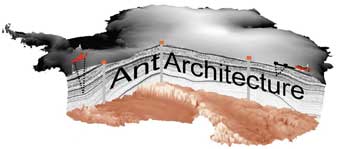The AntArchitecture Action Group aims for the first time to determine the stability of the Antarctic ice sheets over past glacial cycles directly from the internal architecture of the ice. Internal architecture describes the 3‐D internal structure of the ice imaged by multiple radar‐sounding surveys undertaken across Antarctica over the last five decades.

Determining the stability of different parts of Antarctica is crucial because there is mounting evidence that collapses of polar ice sheets fed rapid global sea level rise up to 9 m higher than today during the last interglacial period, ~127‐116 ka. In this context, the volume and current behaviour of ice in Antarctica give cause for concern: both the West Antarctic and East Antarctic ice sheets (hereafter WAIS and EAIS respectively) contain sufficient ice to raise global sea levels by 58 m. Since the onset of satellite observations in the 1990s, both have lost mass. Present losses from the WAIS contribute an estimated 10% of observed global sea‐level rise, are occurring at ever‐increasing rates, and appear to support the longstanding hypothesis that the WAIS is “unstable”; in other words capable of diminishing rapidly with concomitant impacts on global sea levels. There is also a growing awareness that parts of the EAIS may also be as unstable as parts of the WAIS. There is, therefore, a pressing societal imperative to assess the (in)stability of both the WAIS and EAIS, thereby to gauge how rapidly future changes to both of these ice sheets will contribute to future global sea‐level rise.
The only feasible means for understanding and predicting future Antarctic ice‐sheet behaviour is to use an ice-sheet model (ISM). Crucially, ISMs are typically evaluated with recourse to how well they can produce past behaviour: the user gauges how well the ISM simulates advance or retreat of the ice (typically from dated ice limits) in response to a given climate forcing (derived from deep ice‐core records). When the match is “good,” the ISM is considered reasonable, and it can then, in principle, be used to predict the future ice‐sheet response to projected future climate scenarios. While the last decade has witnessed significant development and expansion of ISM investigations of Antarctic ice‐sheet behaviour, weaknesses in their approach include the sparsity of known glacial limits around Antarctica for the purposes of ISM validation, and a dearth of constraints for ice behaviour in the ice‐sheet interior across glacial/interglacial cycles. To address these limitations, AntArchitecture will take the novel approach of assembling and interrogating, with ice‐sheet modelling, information that the ice itself has recorded about its past behaviour: information that is provided by the radar‐surveyed “internal architecture” of the Antarctic ice sheets.
The AntArchitecture Action Group will bring together key datasets on Antarctic Ice Sheet internal layering from the principal institutions and scientists who have been responsible for acquiring, processing and storing them over the last four decades. Key activities will be coordinating data transfer and data lodging exercises between institutions/countries that will allow datasets acquired by different radar systems to be combined for pan‐continental analysis, and the development of an optimised processing flow for analysis of past data and advice on where future data acquisition needs to be targeted.
The proposed activities directly address two priorities for Antarctic science as outlined by the 2014 SCAR Horizon Scan, namely Understanding how, where and why ice sheets lose mass and Revealing Antarctica’s history. More specifically, the development of a pan‐continental, age‐depth database of Antarctic ice will inform the International Partnerships for Ice Core Sciences (IPICS) activities, including the current major initiative to locate the site to obtain Antarctica’s oldest ice core. Similarly, interaction with IPICS scientists will be crucial for providing dating control on an age‐depth model for Antarctica using internal layering. AntArchitecture’s age‐depth volume across Antarctica will provide a resource for testing ideas developed under the remit of SCAR’s Past Antarctic Ice‐Sheet Dynamics (PAIS) Scientific Research Programme, and will provide datasets of high relevance to the AntClim21 Group. Finally, we note that AntArchitecture’s vision to provide maps of internal surfaces of given ice age across Antarctica builds upon the SCAR‐coordinated BEDMAP2 and ADMAP efforts, wherein distinct datasets were successfully brought together to produce reconciled maps of Antarctica’s subglacial topography and magnetic signals. Therefore, a model for successful collaboration between the relevant data providers spread throughout the SCAR community already exists.


